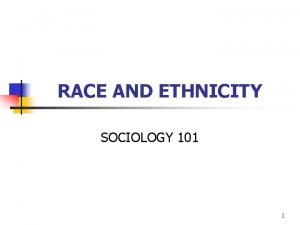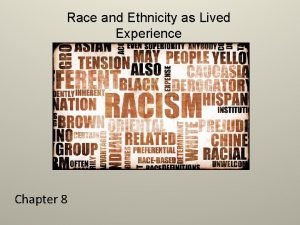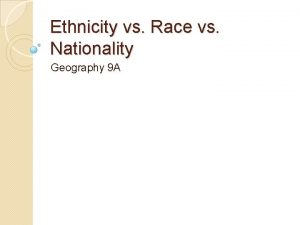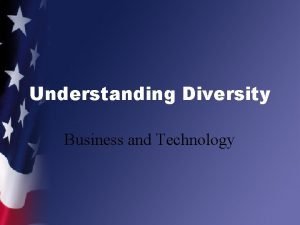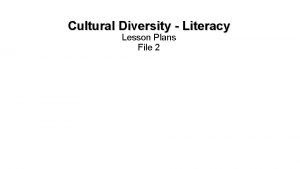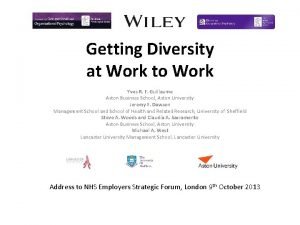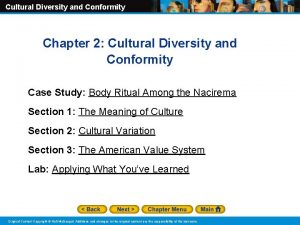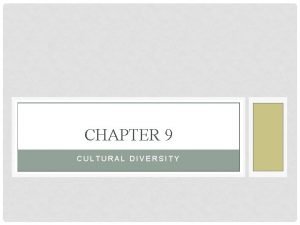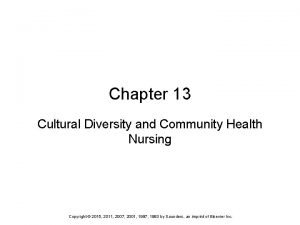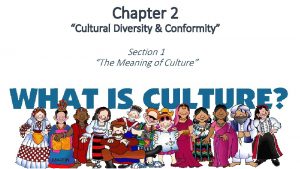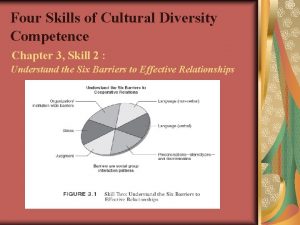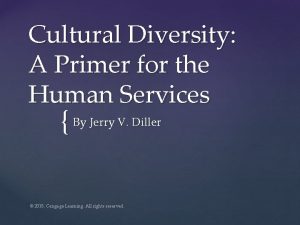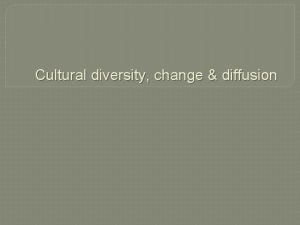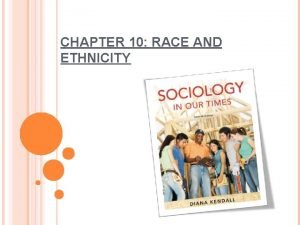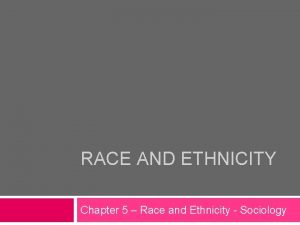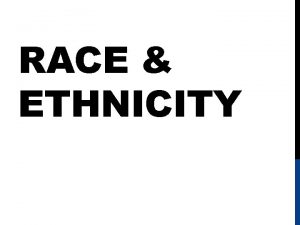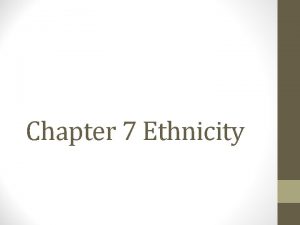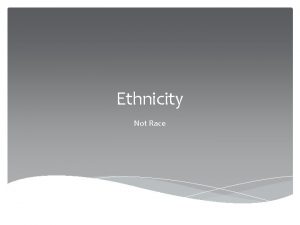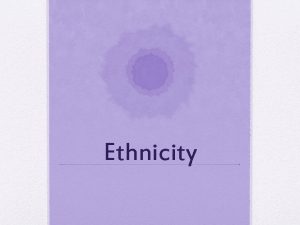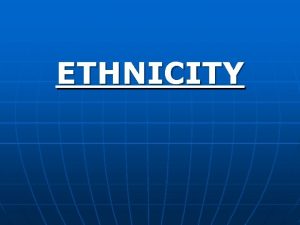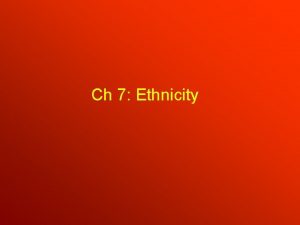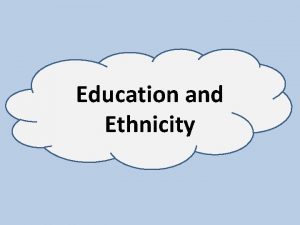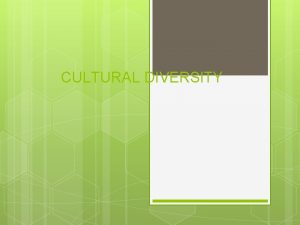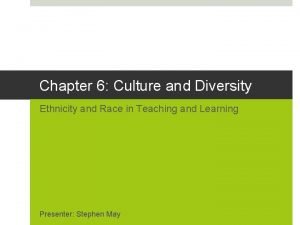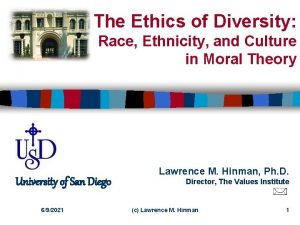Cultural Diversity UNDERSTANDING CULTURE ETHNICITY RACE AS IT




















- Slides: 20

Cultural Diversity UNDERSTANDING CULTURE, ETHNICITY, & RACE AS IT RELATES TO THE HEALTH CARE FIELD

WHAT MAKES A PERSON UNIQUE? � Physical � Education characteristics � Family Life � Socioeconomic status � Religious beliefs � Location � Occupation � Life experiences � Cultural/ethnic heritage

CULTURE � values, beliefs, attitudes, languages, symbols, rituals, behaviors, & customs unique to a particular group of people & passed from one generation to the next. • “Set of rules” • All cultures have 4 characteristics: -Culture is learned -Culture is social in nature -Culture is shared -Culture is dynamic & constantly changing.

ETHNICITY � Classification of people based on national origin and/or culture. � Can share a common geographical location or heritage but may not share same beliefs. � Examples include – African American, Asian American, European Americans, Hispanic Americans, Middle Eastern/Arab Americans, Native Americans

RACE A classification of people based on physical or biological characteristics such as the color of skin, hair, and eyes; facial features; blood type; and bone structure. � � Race cuts across multiple ethnic/cultural groups. Example: -Blacks from Africa & Blacks from the Caribbean both share many of the same physical characteristics, but they have different cultural beliefs and values. -White or Black Hispanics -White Africans & Caribbean's -White & Black Asians

WHAT IS CULTURAL DIVERSITY? � The � � � differences based on cultural, ethnic, & racial factors. Cultural assimilation – absorption of a culturally distinct group into a dominant or prevailing culture. Requires that the newly arrived cultural group alter unique beliefs & behaviors & adopt the ways of the dominant culture. Acculturation – process of learning the beliefs & behaviors of a dominant culture and assuming some of the characteristics. Sensitivity - the ability to recognize and appreciate the personal characteristics of others.

BEHAVIORS & THEIR CULTURAL SIGNIFICANCE

TERMS � Bias – preference that prevents impartial judgment. � Ethnocentric – Individuals who believe in the supremacy of their own ethnic group. � Prejudice – “pre judge” a strong feeling or belief about a person or subject that is formed without reviewing facts or information. � Stereotype - an assumption is made that everyone in a particular group is the same. � Holistic Care – care that provides for the well-being of the whole person.

FAMILY ORGANIZATION

WHAT IS FAMILY ORGANIZATION? �The structure of a family and the dominant or decision making person in a family. �Families vary in their composition and in the roles assumed by family members

2 TYPES OF FAMILY ORGANIZATION Nuclear Family Extended Family Mother, Father, & Children. Can also consist of a single parent and child(ren) Nuclear family + grandparents, aunts, uncles, cousins.

FAMILY TERMS…. � Patriarchal – Father or oldest male in the family is the authority. � Matriarchal – Mother or oldest female in the family is the authority. How does this affect health care? -If a family is patriarchal, the dominant male will make most health care decisions for all family members. -Regardless of who is in authority, respect for the individual and the family must be the primary concern

LANGUAGE

�In the United States the dominant language is English. � 20% of the US population under age 65 speaks a language other than English at home.

HOW TO CARE FOR NON-ENGLISH SPEAKING PT’S � Whenever possible find a translator or a family member who speaks the language. � Speak slowly & use simple words. � Use gestures or pictures to clarify the meaning of words. � Use nonverbal communication (smile/gentle touch) � Avoid the tendency to speak louder � Try to learn some words or phrases in different languages

PERSONAL SPACE & TOUCH

PERSONAL SPACE & TOUCH � “territorial space” � The distance people require to feel comfortable while interacting with others. � Some cultures use close contact (comfortable standing very close to and even touching � some cultures use distant contact (opposite of close contact)

CULTURES & TOUCH � � Arabs – very close contact, will touch, � smell, & feel people. French/Latin – tend to stand very close while talking. Hispanic – comfortable with close contact & use � hugs & handshakes. Gender- women tend to stand closer than men do and children stand closer together then � adults. European/African Americans – prefer some space during interactions but do � not hesitate to shake hands as a � greeting. Asian – stand closer but usually do not touch. � Affection is reserved for intimate relationships but never in public. Cambodia – members of the opposite sex will never touch in public, even siblings. Vietnamese – only elderly can touch Middle Eastern – men may not touch females who are not family. Native Americans – personal space is important but they will lightly touch another person’s hand during greetings.

EYE CONTACT � Most European Americans regard eye contact during a conversation as a sign of interest and trustworthiness. � Asian Americans consider direct eye contact to be rude � Native Americans may use peripheral vision and avoid direct eye contact. � Hispanic & African Americans may use brief eye contact � Muslim woman may avoid eye contact as a sign of modesty � In India, people of different socioeconomic classes may avoid eye contact

GESTURES � Common gesture in the US is nodding the head up and down for “yes” and side to side for “no”. � In India, the head motions for yes and no are the exact opposite. � Asians and Native Americans feel pointing is a threat, but in the US it is commonly used to point out something.
 Definition of race and ethnicity
Definition of race and ethnicity Chapter 8: race and ethnicity as lived experience
Chapter 8: race and ethnicity as lived experience Race vs ethnicity vs nationality
Race vs ethnicity vs nationality Data race vs race condition
Data race vs race condition What is a turbine
What is a turbine Design of dams
Design of dams Why is genetic diversity important
Why is genetic diversity important Ecosystem jigsaw activity
Ecosystem jigsaw activity Regional diversity
Regional diversity Are west african bantu
Are west african bantu Cultural diversity 3939 answers
Cultural diversity 3939 answers Melting pot salad bowl
Melting pot salad bowl Positive and negative effects of cultural diversity
Positive and negative effects of cultural diversity Cultural diversity and conformity section 1
Cultural diversity and conformity section 1 Chapter 9 cultural diversity
Chapter 9 cultural diversity Culturological assessment
Culturological assessment Cultural diversity in phlebotomy
Cultural diversity in phlebotomy Cultural diversity and conformity section 1
Cultural diversity and conformity section 1 Tcole 3939 answers
Tcole 3939 answers Four skills of cultural diversity competence
Four skills of cultural diversity competence Cultural diversity a primer for the human services
Cultural diversity a primer for the human services
